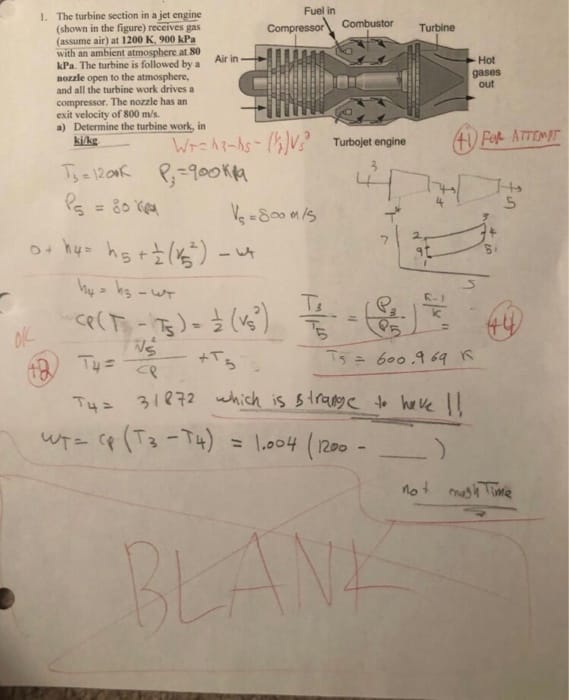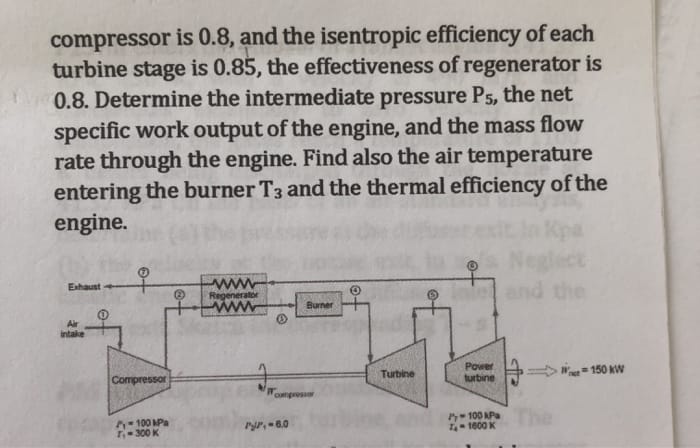

The turbine section
Part I. Special Types of Parametrizations. (a) Suppose a surface is given as the graph of the bivariate function z = f (x, y). The simplest way to form a parametrization from this information is to set o(x, y) = (x, y, f(x, y)). Find o, , , , and N = 0, x6,. Next, consider the curve y(x) = (x, x, f(x,x)), and verify y = dy lies in dx the plane determined by o, and oy . (b) Another special case is when a curve z = f(r) is revolved about the z-axis, forming a surface of revolution. We use polar coordinates for x and y, and set o(r, 0) = (rcos0, rsin0, f(r)). Find o, , , , and N = o, xo, , and then verify o, Lo. (use a dot product). This means a surface of revolution always gives what is called a triply orthogonal system. (c) What condition on f(x, y) will make the system in part (a) triply orthogonal?An aircraft flies at Mach 1.5 at 51000 ft (Pa=11 0KPa,To=216.7 K) propelled by a simple turbojet engine. The air enters the compressor and turbine at a rate of 20kg/s. (7=14,cp=1005J/{kg.Kj). a Find the stagnation temperature and pressure into the compressor, if the inlet is effectively isentropic. b. The engine compressor has a pressure ratio of 15 with an isentropic efficiency of 8516. Find the compressor work input. c. In the combustor the velocities are low (so the stagnation and static pressure are equal] with 596 pressure drop. At turbine entry the stagnation temperature is 1400 K and the turbine has an efficiency of 89%% and 65%% work output from turbine is used as compressor work input. Calculate the pressure ratio of the turbine and the thermal efficiency. d. If the final propelling nozzle is isentropic, find the velocity of the jet Subject on Gas Turbine Engines1. A gas-turbine engine works with air as the working fluid and operates on the simple Brayton cycle. The engine works between pressures of 100 kPa and 2000 kPa. Air at a flow rate of 16.66 m /s enters the compressor at 30"C and leaves the turbine at 600"C. Assume a compressor isentropic efficiency of 85 % and turbine isentropic efficiency of 90%. Using variable specific heats determine (a) the net power output. (b) the back work ratio (c) the thermal efficiency. The turbine section in a jet engine Fuel in (shown in the figure) receives gas Compressor\\ Combustor Turbine (assume air) at 1200 K, 900 kPa with an ambient atmosphere at 80 kPa. The turbine is followed by a Air in Hot nozzle open to the atmosphere. gasos and all the turbine work drives a out compressor, The nozzle has an exit velocity of 800 m/. a) Determine the turbine work, in Turbojet engine (+1) FOR ATTEMPT T's = 1201K P. = 900kk PS = 80 Tim Vg = 800 m /s 4 5 0 + 14= his+ = ( 15) ) - wx CP(T - TS ) = = ( Vs? ) Is OK Ty = CR T5 = 600.9 69 K Ty= 31872 which is strange to have !! WT = cp ( T 3 - T 4 ) = 1.004 /1200 - not mush time BLANcompressor is 0.8, and the isentropic efficiency of each turbine stage is 0.85, the effectiveness of regenerator is 0.8. Determine the intermediate pressure Ps, the net specific work output of the engine, and the mass flow rate through the engine. Find also the air temperature entering the burner T3 and the thermal efficiency of the engine. Regenerally WWW and the Burner Intake Power Compressor Turbine turbine 1ke = 150 KW 100 kPa Pp = 100 APa Ti- 300 K POP, -6.0 I - 1600 K













